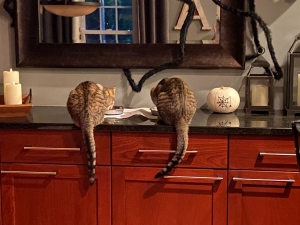6 Essential Steps for Welcoming a New Dog into Your Home
Learn 6 essential steps for welcoming a new dog home. Crate training, playtime tips, diet considerations, and more for a smooth transition!
Learn 6 essential steps for welcoming a new dog home. Crate training, playtime tips, diet considerations, and more for a smooth transition!
Food rotation is one of our best suggestions to improve your pet’s nutrition. We dove in to answer all your questions about when, why, and how to change up your pet’s food!
Meet Rebecca: 20+ years transforming lives through dog training
As everyone is going back into the office or back to school, our dogs will soon be home alone and left to…
Dear NPP,
I love spoiling my dog with new toys. I bring home new ones for him all the time but he gets bored of them so quickly. Nothing really holds his interest for longer than a couple of days. What can I do to keep his interest?
Sincerely,
Drowning in Dog Toys
Giving toys to your dog is a great way to encourage play, enhance mental stimulation, and increase bonding. However, like with everything good in life, moderation is key.
Pro Tip: When exchanging toy collections, inspect them for damage that may be hazardous to your dog. If the toy can easily become a choking hazard, discard the toy immediately.
This is also the perfect time to give those toys a good cleaning! Some rubber and plastic toys are dishwasher safe, but most can safely be cleaned with mild dish soap and warm water. Most plush toys are machine washable.
Having a huge assortment of toys can actually have an adverse effect on your dog. He can easily become overwhelmed and overstimulated, resulting in a lack of excitement around playtime. By removing the “old” toys and replacing them with some that he hasn’t seen in a few weeks, you’re refreshing his play drive with a brand-new variety for him to engage with.
Taking your dog outside is more than a bathroom break. It’s vital to their health and happiness.
Our pets need stimulation and engagement when we’re not home or can’t spend time with them. Let us create our best-selling Boredom Bag for your pet. Each bag is lovingly built with your pet’s unique needs and tastes in mind.
1. Kittens are constantly with each other and absolutely inseparable! If Kiwi can’t find Nala, she will cry out for her until they find each other. Every time I see them, they are either grooming each other, cuddled up sleeping together, or finding mischief together. They even use the litter box one right after the other!
Lesson Learned: Cats create incredibly strong social bonds! I’m so glad we chose to adopt Nala and Kiwi together so they can keep each other company.
2. Nala and Kiwi have a ton of kitten energy, but they burn off most of it around 3 am! We were completely surprised to hear them running laps around the house in the middle of the night – like it’s the Indy 500 – every night! They chase each other, galloping full speed up and down the hallway, occasionally knocking over picture frames and  glassware from tables and counters.
glassware from tables and counters.
Lesson Learned: If you want to sleep at night, engage cats in playtime during the day to let them burn off some energy! We knew cats are naturally nocturnal, but I really underestimated exactly how much energy they would burn off in the early morning hours without daytime play sessions.
3. Both kittens LOVE to hunt! I first noticed this behavior when I saw them watching the birds and bugs outside our window. They sit on the back of the couch and make a ‘chittering’ noise whenever they see something move outside. Then we saw them do it again when we played with the red laser toy! They really do look like their stalking and hunting prey, like a wild cat!
Lesson Learned: Cats – even kittens and indoor cats – are hunters at heart. They have strong natural instincts to stalk, chase, hunt, and catch their ‘prey’, even if it is just the little red laser dot.
4. We really weren’t expecting the kittens to have such voracious appetites. We feed them small meals several times a day, but they are always hungry! We’ve caught them stealing food from our plates right in front of us. When they eat they shake the food with their mouth, like wild cats!
Lesson Learned: With high-activity kittens comes a high food drive and ravenous appetites. Kittens need many small meals each day – more than an adult cat – to stay satiated. Watch out because they’ll eat your dinner, too!
Keep your dog safe with leash training and body language understanding. Follow leash etiquette, advocate for your dog, and use effective tools when necessary.”

DIY Dog Wash closes one hour prior to store close.
Newsletter Sign-Up
Subscribe to get weekly tips, seasonal advice, and be the first to know about events, new products, sales, and more.

